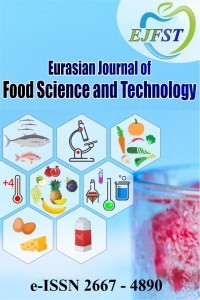Adaptive Neural Network Based Fuzzy Inference System for the Determination of Performance in the Solar Tray Dryer
Adaptive Neural Network Based Fuzzy Inference System for the Determination of Performance in the Solar Tray Dryer
Anfis, , Drying , Solar drying, , Solar tray dryer,
___
- Abbasov T, Yuceer M, Yildiz Z, 2011. Prediction of Cleaning Efficiency of the Electromagnetic Filtration Based Fuzzy Inference System, International Review of Chemical Engineering Process using Adaptive Neural Network,I.RE.CH.E., 3(2):285-289.
- Aboud A, 2013. Drying Characteristic of Apple Slices Undertaken the Effect of Passive Shelf Solar Dryer and Open Sun Drying. Pakistan Journal of Nutrition, 12(3):250-254.
- Askari GR, Emam-Djomeh Z, Mousavi SM, 2008. Investigation of the Effects of Microwave Treatment on the Optical Properties of Apple Slices During Drying. Drying Technology 26:1362–1368.
- Ceylan İ, Aktas M, Doğan H, 2006. Güneş Enerjili Kurutma Fırınında Elma Kurutması, Politechnics Journal, 289-294.
- Choi IH, Pak JM, Ahn CK, Lee SH, Lim MT, Song MK, 2015. Arbitration Algorithm of Optical Flow Based on ANFIS for Visual Object Tracking. Measurement. 75:338–353.
- Cui Z, Li C, Song C, Song Y, 2008. Combined Microwave-Vacuum and Freeze Drying of Carrot and Apple Chips. Drying Technology. 26:1517–1523.
- Decareau RV, 1992. in: Encyclopedia of Food Science and Technology. John Wiley. New York., No:3, pp. 1772–1778.
- Demirhan E, Ozbek B, 2011. Thin-Layer Drying Characteristics and Modeling of Celery Leaves Undergoing Microwave Treatment. Chemical Engineering Communications 198(7):957-975.
- Esen H, Ozgen F, Esen M, Sengur A, 2009. Artificial neural network and wavelet neural network approaches for modeling of a solar air heater, Expert Systems with Applications, 36(8):11240-11248.
- Jang JR, 1993. ANFIS: Adaptive-network-based fuzzy inference system. IEEE Trans. Syst. Man, 23: 665–685.
- Kharb RK, Shimi SL, Chatterji S, Ansari MF, 2014. Modeling of solar PV module and maximum point tracking using ANFIS. Renew. Sustain. Energy Rev. 33:602–612.
- Ochoa-Martínez LA, García-Quintero M, Morales-Castro J, Gallegos-Infante J, Martínez-Sánchez CE, Herman-Lara E, 2006. Effect of CaCl2 and convective Osmotic Drying on Texture And Preference of Apple. Journal of Food Quality, 29:583–595.
- Öztürk H, 2008. Yenilenebilir Enerji Kaynakları ve Kullanımı. Teknik Yayınevi Mühendislik. Mimarlık Yayınları. Ankara.
- Sharma R, Patterh MS, 2015. A New Pose Invariant Face Recognition System Using PCA Optik.126, 3483–3487.
- Yayın Aralığı: Yılda 2 Sayı
- Başlangıç: 2017
- Yayıncı: İlknur BAĞDATLI
In vitro Investigation of Antioxidant Properties of Turnip (Brassica Rapa Subsp. Rapa)
Alihan KOCABAŞ, Ayşegül PEKSEL
Zehra YILDIZ, Leyla GOKAYAZ, Ercan KÖSE, Aydın MÜHÜRCÜ
Natural Plant Pigments and Derivatives in Functional Foods Developments
Olugbenga AWOLU, Oluwatoyin OLADEJİ
Alihan KOCABAŞ, Ayşegül PEKSEL
Vacuum Frying of Selected Shellfish Products
Nano-emulsions: A Novel Approach in Seafood Preservation
Fatima MASSAD, Abdalbasit MARIOD
Proximate and Some Phytochemical Constituents of Three West African Vegetable Spices
Traditional Dried and Salted Nile Fish products in Sudan: A review
Determination of Heavy Metals in Some Fruits, Vegetables and Fish by ICP-MS
Ayşe Hümeyra İSLAMOĞLU, Tuğba KAHVECİOĞLU, Gökçe BÖNCE, Esra GEDİK, Fatma GÜNEŞ
